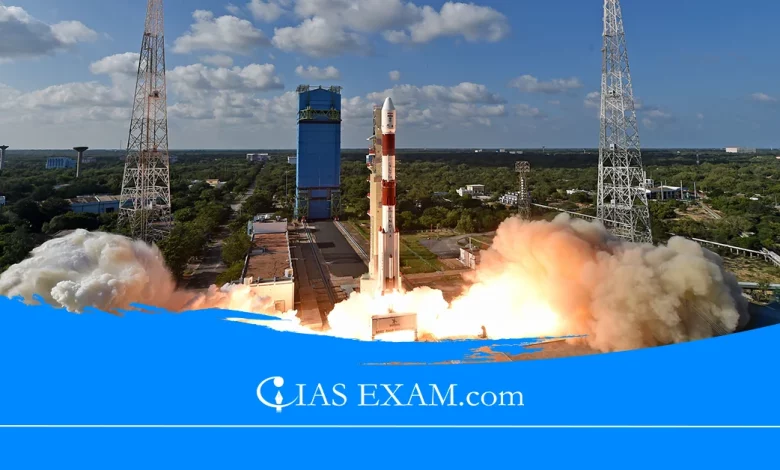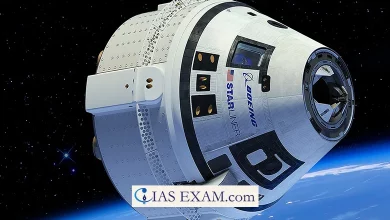Daily Current Affairs for UPSC
Private players in space industry
Syllabus - Science and Technology [GS Paper-3]

Context
The Chennai-based space start-up will launch its first rocket Agnibaan Sub Orbital Technology Demonstrator from the Satish Dhawan Space Centre.
India’s share in Space Industry
- India constitutes 2-3% of the global space economic system and is predicted to decorate its share to more than 10% by 2030.
- With over 400 private space companies, India ranks fifth globally in space companies.
Private players in Space Industry
- Indian start-ups are taking active interest in the space market, from only 1 start-up in the space region in 2012 to 189 start-ups 2023.
- The investment received by those start-ups reached a total of $124.7 Mn in 2023 from $67.2 Mn in 2021.
- The Skyroot, have launched India’s first privately built rocket, Vikram-S, into space, with plans to revolutionize satellite launches.
Regulation of the Private sector in the Space industry in India
- National Space Promotion and Authorisation Centre (IN-SPACe): It is an autonomous and single window nodal agency in the Department of Space for the promoting, encouragement and law of space activities of both government and private entities.
- NewSpace India Ltd (NSIL): It is mandated to transfer the matured technologies developed by the ISRO to Indian industries.
- All of them are under the purview of the Ministry of Defence.
Steps taken by Government
- SpaceTech Innovation Network (SpIN): SpIN is a one-of-its-kind public-private collaboration for start-ups and SMEs in the space industry.
- The Indian Space Policy 2023 was notified to put in force the imaginative and prescient for unlocking India’s ability in the Space sector through more advantageous non-public participation.
- Various schemes to inspire the private zone had been applied by IN-SPACe, i.e., Seed Fund Scheme, Pricing Support Policy, Mentorship help, Design Lab for NGEs, Skill Development in Space Sector, ISRO facility utilization assist, Technology Transfer to Non-Governmental Entities (NGEs).
FDI in space sector
- Under the amended FDI policy, 100% FDI is authorized in the space sector. The access direction for the various activities are as follows:
- Up to 74% under Automatic route: Satellites-Manufacturing & Operation, Satellite Data Products and Ground Segment & User Segment.
- Up to 49% under Automatic route: Launch Vehicles and related structures or subsystems, Creation of Spaceports for launching and receiving Spacecraft.
- Up to 100% under Automatic route: Manufacturing of additives and structures/ sub-systems for satellites, ground segment and user segment.
Significance of privatization of space sector
- Private companies function with a profit purpose, which drives them to reduced costs in space missions and satellite launches.
- Privatization introduces competition into the space industry, which could force performance and innovation.
- Private gamers facilitate the commercialization of space programs and services for agriculture, disaster management, urban making plans, navigation, and communique, amongst different sectors.
- Private organizations have a higher degree of autonomy in making decisions, which permits them to take in new initiatives.
- It can generate employment, enable modern technology absorption and make the arena self-reliant.
Challenges
- Space technology is expensive and needs heavy investment. This kind of lucrative power is available only with selected rich corporates, thus can lead to monopolization of the sector.
- Building and operating space technology and infrastructure require specialized technical understanding and resources.
- Protecting intellectual property rights (IPR) is critical for incentivizing innovation and investment inside the space quarter.
- Indian private companies in the space sector have to face stiff competition from the established players such as SpaceX, Blue Origin etc in the international market.
Way Ahead
- Private entities are now actively involved in crucial aspects of research, manufacturing, and fabrication of rockets and satellites, fostering a vibrant environment of innovation. It is anticipated to combine Indian organizations into global value chains.
- With this, organizations might be capable of installing their manufacturing centers in the country duly encouraging ‘Make In India (MII)’ and ‘Atmanirbhar Bharat’ projects of the Government.
Source: The Hindu
UPSC Prelims Practice Question
Q.With reference to India’s satellite launch vehicles, consider the following statements: (2018)
- PSLVs launch the satellites useful for Earth resources monitoring whereas GSLVs are designed mainly to launch communication satellites.
- Satellites launched by PSLV appear to remain permanently fixed in the same position in the sky, as viewed from a particular location on Earth.
- GSLV Mk III is a four-staged launch vehicle with the first and third stages using solid rocket motors; and the second and fourth stages using liquid rocket engines.
Which of the statements given above is/are correct?
a. 1 only b. 2 and 3
c. 1 and 2 c. 3 only
Ans- “a”





.png)



